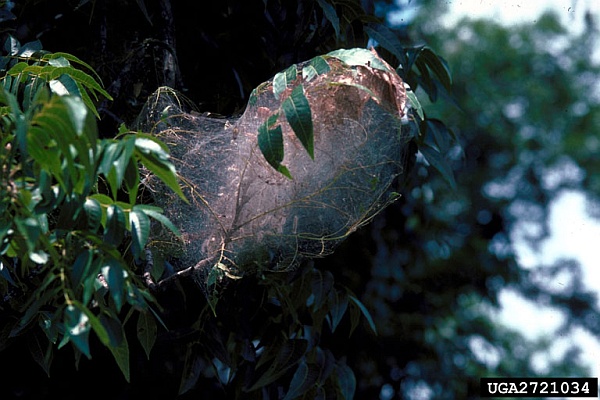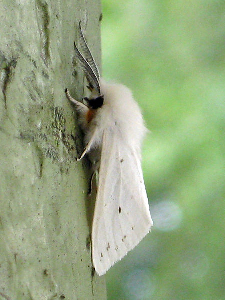
If you haven’t seen these webs in the trees, you will soon.
These are the communal webs of fall webworm caterpillars (Hyphantria cunea).
Their mother laid a mass of eggs on a deciduous tree, preferably a cherry, apple, ash or willow. A week later the eggs hatched into tiny caterpillars and they began to build their web, mostly at night.
The caterpillars live inside the web, molting as they grow, and extending it to surround the leaves they’re eating. The web can become as much as three feet long but it’s very different from the tent webs we see in the spring.
Tent caterpillars build in the forks of branches and come out of their nest to eat. Fall webworms build at the tips of branches and stay inside to eat, only emerging on very hot days (too hot to stay inside!) or when they’ve reached their final instar and are ready to pupate.
Hyphantria cunea overwinter in the pupal stage under loose bark or debris on the ground. When they emerge in the spring they look like this with a 2″ wingspan:
Unless you have an infested orchard, fall webworms aren’t that bad for trees and they’re quite good for birds.
The caterpillars don’t permanently harm the trees because they’re eating the leaves at the end of the growing season when the trees would drop them anyway.
And they’re an important food source for birds. Migrating warblers see the webs as huge advertisements: “Come eat! Good protein inside!”
When you see fall webworms in the trees, think “happy warblers.”
(Web photo by G. Keith Douce, University of Georgia, Bugwood.org. Moth photo from Wikimedia Commons. Click on each photo to see its original.)

Whew,
I was just starting to worry about them. A man in the neighborhood just told us they were stink bug nests, which I questioned b/c I thought stinkbug laid their eggs on the leaves of garden veg! Thanks for accurate info.
There are a couple of these tents in our crabapple trees, and we have noticed birds showing some interest in them. Now that we know they aren’t bad for the trees, we can relax and enjoy the show.
Sort of along these same lines, do you know if cicadas are a significant source of food for some birds? I know I’ve seen birds go after them a couple times, but I was wondering if that was more of an exception or the norm. It seems to me that cicadas would be a bit of a tough nut to crack, especially since I remember the cicadas getting away both times I saw this.
Now completely off-topic, do you know where I could find out the name of an insect I saw mowing yesterday? It looked like a cross between a katy-did and a grasshopper, and it had something looked like a toothpick sticking out of its backside and a bold white stripe down its back. I honestly have no clue where to find a good web-sight for identifying insects and thought that you might know of one.
Birds do eat cicadas, but as you’ve noticed they’re hard to catch.
For bug guides on the web, try the BugGuide at http://bugguide.net or Insect Images http://www.insectimages.org/
The adult is quite glamorous looking.
Love that title, Kate!
To Josh above: that “toothpick” sounds like an ovipositor.
And there’s something else that “eats” cicadas — Cicada Killer Wasps. . . or at least their larvae do!
Here’s a video on youtube of a Cicada Killer stinging a cicada http://www.youtube.com/watch?v=mLtCPI_dM3c/
And Scott Shalaway just wrote a column on them on Sun. Aug 7th
‘Cicada Killers Live Up To Their Grisly Name’
http://www.post-gazette.com/pg/11219/1165600-140.stm
Rob
Well, as I expected I found out that. . . entomology is no piece of cake 🙁 . However, I love the sites and am definitely adding both to my favorites. The closest thing I found was a Drumming Katydid, but I don’t think that was it.
http://bugguide.net/node/view/8022/bgimage?from=0
Thanks a lot Rob, although I still think it’s more dramatic to describe it as a toothpick than an ovipositor 😉 . Nevertheless, I found the little research I did to be fascinating, so I plan to check that out further.
@ cicada killer: way to go! Take out those noisy little buggers!
It’s no wonder the things are hard to catch, though, they’re built like tanks! I guess that’s a requirement for noisy, annoying creatures. How else would anything that infuriating survive? 😉